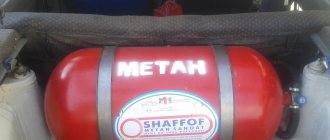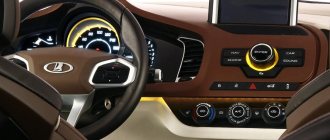A manual transmission has been installed on the Lada Vesta since the first car left the assembly line in the basic version. But the designers initially installed the robotic gearbox on the Lada Granta and Priora, and only then began to produce the Lada Vesta with the AMT robot. The robot, based on a serial mechanical box, has remained virtually unchanged, but was jointly refined with ZF designers. More specifically, this is a regular VAZ gearbox with an automatic control module.
Despite the fact that cars of another Lada model range today are equipped with Renault manual gearboxes, on Vesta the designers installed the original VAZ one. Why? AvtoVAZ representatives explain this by the lower load on the box due to its automation and the use of design solutions that reduce overall costs, with an emphasis on the competitiveness of the model in the car market. And ZF, which is engaged in the robotization of “mechanics,” offers in this box the latest generation of a module with newer switching algorithms and fine-tuning of the operating logic.
Reviews about the robotic gearbox
There are many reviews on the Internet about Vesta with AMT, the majority are, of course, not very positive, due to the established views of car enthusiasts that all Russian automatic transmissions are bad, especially in comparison with “classmates” from Europe. In fact, the Russian auto industry really still lags behind Western manufacturers in the use of new technologies and robotic assembly, but in operating conditions on Russian roads and in the price-quality ratio of Lada, including the flagship of the Lada Vesta plant, it is very good and, most importantly, reliable, option for Russian consumers. The AvtoVAZ robotic gearbox installed on the Lada Vesta is not yet so popular, but it already has its advantages. It should be noted right away that the VAZ robot with AMT is not a full-fledged analogue of an automatic transmission and their comparison will not be entirely correct.
Automatic expected
Many people are concerned about the issue of the machine gun. The predecessors Kalina and Grant already had a four-speed Jatco automatic, why isn’t it on the 2180? The fact is that there is no suitable base for the machine gun on the Lada Vesta. The mentioned box is already outdated, and purchasing a new one will significantly increase the price of the car, which is contrary to the policy of the Volga Automobile Plant.
Novaya Lada: Oh!
Company President Nicolas More denied rumors about a 4-band automatic transmission for the most popular Lada models. So will the Lada Vesta have a gun? Most likely Yes. It will be a 6-speed modern transmission. Negotiations are already underway on the creation of a new plant in the Russian Federation; automatic transmissions will be created at the plant with the support of foreign companies. The appearance of an automatic machine on the Lada Vesta should be expected in at least 4-6 years.
Advantages of the robot (AMT)
So, manufacturers have already announced positive qualities - this is, as mentioned above, low load and, accordingly, an increase in the service life of the box, as well as a reduction in production costs compared to foreign analogues. Positive reviews from car enthusiasts can already highlight the strengths of the Lada Vesta with robotic AMT: - fuel consumption is lower than when using an automatic transmission, - lubricants do not require replacement, and the clutch disc is designed for the entire service life of the box, - the robotic 5-speed gearbox is equipped with protection from chaotic switching of modes, preventing its breakdown, allows you to move in both automatic and manual modes - AMT understands commands well, with careful and measured work with the gas pedal, it moves smoothly from one gear to another, the existing delays when changing gears are small ( no more than 120 ms), - when a loaded car starts downhill, the “robot” adapts and begins to work more harshly, at the same time the hard start algorithm and the slope start assistant are triggered. — the absence of a “creeping mode” ensures reliability; to start, you need to put the lever in position “A” (auto mode) and lightly press the accelerator, the start occurs faster, without jerks and vibrations.
Vehicle inspection
It all starts in the little things. We approach the car from behind and try to open the trunk. At first it doesn’t work because there is no open button. What you need to do to do this is press the button on the key fob. After a few seconds everything worked. Let's go further and look into the trunk, it's quite decent. There are hinges, which are also found on all budget sedans. Secondly, the upholstery is made of something unknown. There is plenty of legroom in the rear seats and the car is spacious.
As for the Lada Vesta engine. If it had not had a VAZ engine, the car could have been much more expensive. It's the same story with the gearbox. There are manual transmissions; they don’t make automatic transmissions in Russia. Therefore, we decided to take a classic VAZ gearbox and attach attached electronics to it, control systems that can be purchased, and get our own gearbox. And so they did. The node that stands is called the AMT robot. In essence, it is a five-speed VAZ manual with additional equipment. That's why the car only has two pedals.
Disadvantages of the robot on the Lada Vesta
The disadvantages of the robot are, in principle, standard, the main ones are: - first of all, gear shifting with a slight loss of traction torque, unlike an automatic transmission; and a long second gear with an inevitable whine and drop in acceleration when shifting.
A measured ride in a Lada Vesta with robotic AMT is surprisingly comfortable, but in any case, the car enthusiast will put the last point in the dispute.
Be careful with the selector!
On the highway, the car's directional stability is not high, and the steering wheel is "indistinct". It seems that he is slightly unable to keep up with the wheels: they have already swerved to the side, and the steering wheel deviates a little later. Gusts of strong wind add to the severity of the situation; sometimes the car simply moves in a sinusoid, albeit within its lane. I look closely at my colleagues in the movement: few, apparently, experience the same problems.
The advertising brochure promises that Vesta will isolate riders from excess noise outside. How to say... Sometimes I hear a strange periodic rustling noise from under the wheels, as if the tires find themselves on sections of asphalt of varying roughness. I am gradually realizing that the sound occurs when the tires touch the markings. Since they are clearly audible, we can conclude that the sound insulation of the interior of the VAZ new product is not so good.
What about your own sounds? Their car also produces a lot. The hum of the windshield washer motor readily penetrates into the cabin. The engine's operation becomes audible to the driver already at approximately 3000 rpm. The box is also not silent - it howls slightly. And how many “crickets” are there behind the interior trim panels! Their main colonies live behind the dashboard and inside the driver's door. They are awakened to life not only by road irregularities, but also by loud music.
But that would be okay. If I owned Vesta, I would not be lazy, dismantle the doors and destroy at least some of the “insects”, gluing in places additional noise and vibration insulating linings. But what to do with the annoying signal that starts beeping when you reach 120 km/h? Let's not pretend to be righteous and claim that we only drive within the official speed limits. 120 is not a speed for modern cars, especially on open, well-cleared and highly visible highways away from populated areas. Vesta is no exception. Secretly from the observant traffic police, I accelerated the car to 150 km/h. At such a speed, the sound of the warning signal, of course, was drowned in the general noise, as well as in the sounds of music. But you can’t drive like that anywhere, ever. And we often exceed 120 km/h when overtaking. So this signal is frankly annoying on long trips.
Our test included a 1.6-liter version of Vesta with a capacity of 106 hp. With. with automatic transmission. The problems with AMT operation on the VAZ sedan are the same as on the Xray crossover. In the same way, the box seems to “sigh” before shifting up the gear. When driving slowly in traffic jams, this is not noticeable - in fact, because the movement occurs in one gear, first or second. The situation is much worse when the car is required to “shoot”, an intense jerk forward. For example, you need to fit into the flow when leaving the yard or from a secondary road to the main one. At the most crucial moment, AMT can “fail,” and this is very unpleasant.
At high highway speeds, shifts are not accompanied by “sighs” - they simply don’t have time. AMT quickly goes through all the stages and stops at the highest - the fifth. If acceleration is necessary, kick-down is triggered and one stage is reset, also without a noticeable “failure”. But take the risk of accelerating more intensely. If you reset two gears at once, there will be such a delay that it may seem as if the AMT is completely stuck. Imagine that when accelerating in a manual car, you press the clutch pedal at the peak of acceleration... Vesta demonstrates something similar.
It's a pity! The dynamics, even of the 106-horsepower version, are not bad at all. At 80 kilometers per hour, I press the gas pedal to the floor and start counting down the seconds. Naturally, first there is a “failure” (AMT dropped two gears), and at least a second is lost. After 9 seconds, the speedometer needle almost reaches o, and then the AMT shifts to an up gear, as a result of which we lose another second. Total - 10 s., however, this is not so bad, right?
Moreover, the result can be improved by selecting manual mode. No, not fifth gear, acceleration in it will take half an hour. And not the fourth, it will lose a second, or even two, to the automatic mode. The third is your choice. Nine-second acceleration is guaranteed. It could be the best, but the tachometer needle flies up to the red zone, and a “jump” to the fourth stage follows. Thus, it is possible to “deceive” the transmission, but not the engine.
How much nicer and more logical a car with a manual transmission behaves! About a year ago I managed to ride this modification a little. It seemed like a new car for me, but after just a few seconds of driving I felt like it was my own. Convenient location of the lever, a clear “hit” in each stage and fixation in it, a quick determination that the “pickup” of the engine begins at approximately 3000 rpm, and, accordingly, it is at this mark that you should switch to an “up” gear for the most intense acceleration... No, positively, when choosing Vesta for myself, I would definitely choose the version with a manual transmission.
As I already said, the AMT selector “walks” along its grooves very easily. It does not move from the positions selected by the driver, but accidentally pushing it with your hand is a couple of trifles. While stopping, did you find that for some reason the engine does not start? Check the location of the selector, you have probably moved it to position A or R. But sometimes the engine does not want to start, even when the selector is in “neutral”. For no apparent reason, starting occurs only when the ignition key is turned again. The reason is unclear.
And one more thing: in winter, in the Vesta cabin, I’ll tell you straight, it’s not hot. Even if you turn the temperature regulator to maximum. The climate control system display here is the same as in the Xray, but it is easier to read; apparently, the driver looks at it from a slightly different angle. But all is not well with the heat. I accidentally discover that for some reason the previous driver blocked all the deflectors. When I open them, it gets better. But still…
Moreover, in city traffic jams the interior warms up (although not to the point of heat), but on the highway it becomes cool inside again. I think this is related to the temperature of the engine: when driving slowly or “threshing” in a parking lot, the needle of its indicator moves two to three millimeters above the 90-degree mark, and when moving quickly, two to three millimeters below.
Along with the temperature, the battery charging voltage also fluctuates. It is indicated by the on-board computer, and this is a plus. Usually about 14.3 V is displayed. Good. I turn on the audio system, heater, air conditioning, heated seats, high beam headlights. The result is 13.7 V, which is also not bad. But when I add to this the heating of the front (entire area) and rear windows, only 12.5 V remains, and this is an undercharge. Although, of course, the driver usually uses these two “heating” systems for a short time.
As was discovered under the hood, the Vesta’s battery is small, and on the test car it was completely devoid of any labels. It is unclear what its standard capacity is. According to unofficial data, it is 62 Ah, which is not much.
The LADA Vesta sedan is offered on the market at prices ranging from 545,900 rubles to 778,900 rubles. A total of 8 trim levels are available. Engine and transmission combination options: 1.6-liter engine plus manual; 1.6-liter engine plus AMT robotic gearbox; 1.8-liter engine plus AMT. The robotic gearbox adds 25,000 rubles to the price of the “mechanical” version, and a car with a 1.8-liter engine will cost just as much more. The basic Classic package already includes ABS, ESP, electric power steering, on-board computer, and heated front seats.
The 1.6-liter Vesta engine is covered with a decorative and noise-insulating cover. We have already noticed that it is actively splashed with mud when moving, the engine lacks a seal under the front edge of the hood. But if you remove the cover, you will find that the motor underneath is clean. Only now it is installed on ordinary threaded rods, and not on “ball joints”, as usual. The designers clearly saved money on these small details.
The Vesta power unit allows the use of both 95 and 92 gasoline. During the test, I filled the car with 95. Its consumption in urban traffic jams reached more than 11 liters, but on the highway it dropped to 8.2 - 8.3 liters per 100 km. In general, these are good indicators, considering the speeds at which he moved, test acceleration and braking.
The suspension of the new VAZ product is a bit harsh. There are MacPherson struts installed at the front and a continuous torsion beam at the rear. The car does not like either large or small irregularities; give it the smoothest possible roads. In theory, such a suspension should “hold” it well on high-speed straights, but this does not happen. On flat arcs the situation is better. The electric power steering steering wheel, which makes approximately 2.8 turns from lock to lock, becomes heavier as speed increases and even demonstrates a reactive action, but it is disconnected from the wheels. They are too “independent”, especially when driving at high speeds on the highway.
Let's not slow down!
The previous robot did not allow us to start from second gear. Because of this, in icy conditions I sometimes had to involuntarily skid. Now a “winter” operating algorithm has been introduced into the control unit. Just don’t look for a key with a snowflake near the gear selector in Vesta. The second gear must be engaged manually by moving the lever to manual control mode. After jerking around in the “creeping” mode, I was skeptical, but in the “winter” mode the car starts moving quite confidently - although, of course, with the help of the right pedal. Pass!
Design
It’s difficult to talk about design, because everyone has their own ideals and everyone compares them with them. Everyone can decide for themselves by seeing the Lada Vesta in the video.
What is bad about appearance? There is something bad in the rear arch area. If the rear suspension is semi-independent, then a normal trunk can be made only due to the height of the rear part. That’s what they did, and it wasn’t only Vesta who suffered this misfortune.
Many cars would be more beautiful if the manufacturer did not strive for the cheapness and simplicity of the rear axle.
Personally, I don’t like this branded X stamping on the side. There is fire in front, but on the sides it somehow looks tacky, in my opinion.
Well, let's not get into the jungle of tastes and colors. By the way, the color choice has now become very bright and rich.
In total, we have an appearance that does not leave anyone indifferent and is recognizable. This is a confident step forward.
The interior is standard for budget subcompacts. Although you could play with X's. A large number of edges and curves distracts from the quality of materials, while the use of such a technique would be justified - X Design.
Didn’t guess or were afraid to scare the conservative audience? In fact, we get a simple and standard interior for the class and price segment.
And we will make Avtovaz, as usual, an amendment to the old. Let's say: “Well, cooler than in Priora.” Well, I’ll add, even Logan will get nervous.
Problems with the Robot
The AMT (robot) mechanism itself is quite reliable: The box is painfully familiar to all of us, and the actuator inspires confidence. The actuator has a service life of 10 years, officially it is not repairable, but now they do everything, and repairing such an actuator is not a problem, the main thing is to lubricate it well. But there are the following “jambs” with the robot, but mainly related to the first, early models:
Long switching . As mentioned above, this is not a problem, it is a feature. Use manual mode.
Valeo clutch . As it turned out, Valeo does not match the Vesta in terms of vehicle weight, which is why current models receive a Sax clutch. Valeo quickly wore out, there was a difficult start, slippage and clutch smell were felt. The first Vesta models received the Valeo clutch.
In fact about the robot: Is it worth buying a car with a Robot?
If you are interested in the question of whether it is worth buying a robot, we will tell you: sign up for a TEST DRIVE, because it is free. Only by experiencing the robot’s operation yourself will you be able to understand whether it is suitable for you or not. If it doesn’t fit, then a manual transmission package is waiting for you.
AvtoVAZ says that the gearbox is suitable for everyone; AMT has 20 different switching algorithms. But this is not entirely true.
A little from myself: If you have a harsh character and you need appropriate behavior from a car, a robot is not for you. The robot is designed for calm, leisurely driving at medium speeds with smooth shifts and saving fuel and the clutch disc. And the question immediately arises of how this transmission will perform on Vesta Sport: how much the settings will be changed, whether sportiness will appear, etc.
Fuel consumption
The vehicle's stated consumption is 6 liters of gasoline per 100 km on the highway. By the way, you can pour 92. And 9.3 liters per 100 kilometers around the city. This is a passport expense.
But in real conditions I got about 10 liters. I must say that I pedaled quite aggressively, as I was experimenting with the VAZ gearbox. In general, more than stated, since this is a mixed cycle, after all, and not just a purely urban one. But the consumption, in my opinion, is very good.
What about sound insulation? She is.
Multimedia system
Another thing that cannot be ignored is the local multimedia system. In this case, we have a color screen, a touchscreen, and a sophisticated entertainment system, which is offered only in the most expensive versions. Let's try to test it. We grabbed a flash drive with music and video files. The performance of such systems is simply determined. She reads everything she is asked to read.
Read: Lada Vesta radio without a screen.
There is also navigation - a strange thing with maps. As for our Russian localities, the map knows almost nothing about them. But, at the same time, there is a detailed map of Italy. This is a mockery of the potential owner of Vesta, who only knows about Italy from TV! This is a consequence of a difficult fate. Therefore, it is better to remain silent about navigation.
Appearance
In general, the Lada Vesta is a decent car, but there are some problems. If the weather had been sunny now, we would not have seen anything on the instruments. Everything is glare, the numbers are not visible, there is no brightness adjustment. There is a trip computer, which is quite decent. Its numbers are visible in any light. Then things start to get weird again. The windshield is heated - you can see the threads that are built into it and should warm the glass.
Front and rear heating is turned on with one button. But for some reason the front one takes a long time to warm up, it’s easier to clean the glass yourself. There is no heated steering wheel, although we have a cold climate. But the heated seats provide good warmth. If you compare it with Mazda, it has heating with three positions, everything is done in a complex, modern way. You turn it on and wait a long time before it starts to heat up. After half a minute it becomes warm, and after two minutes you already want to turn it off.











